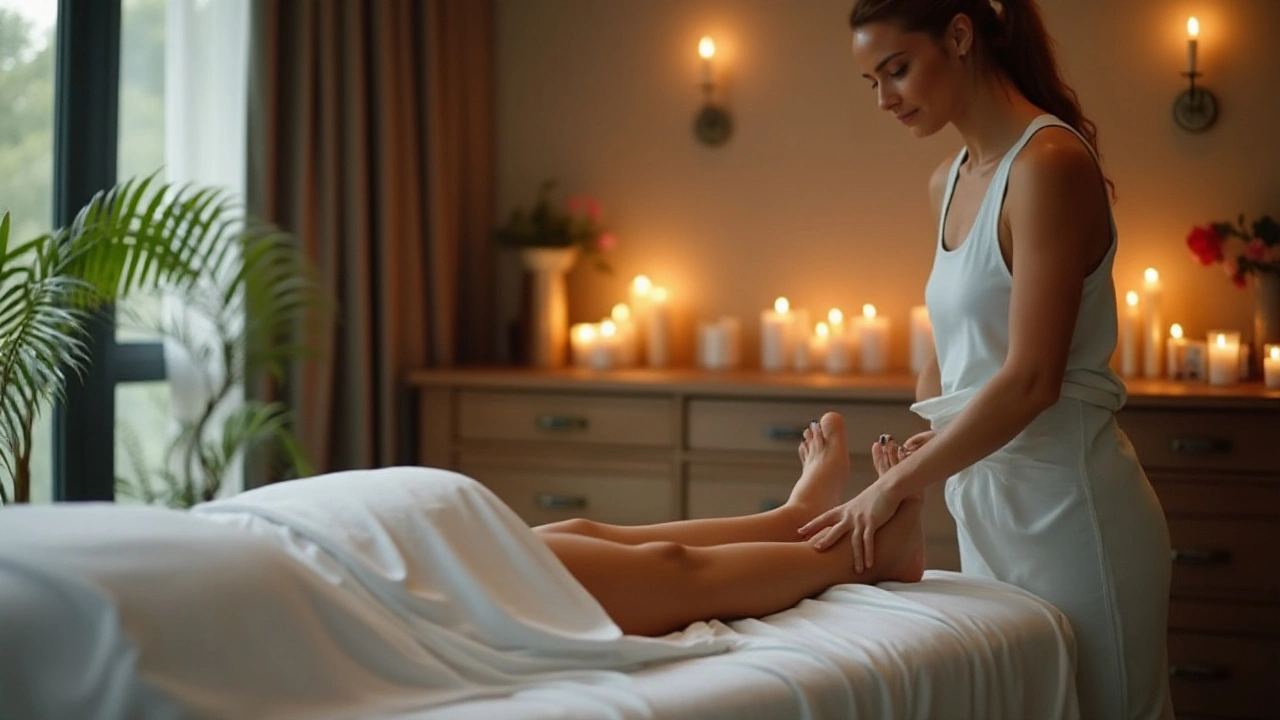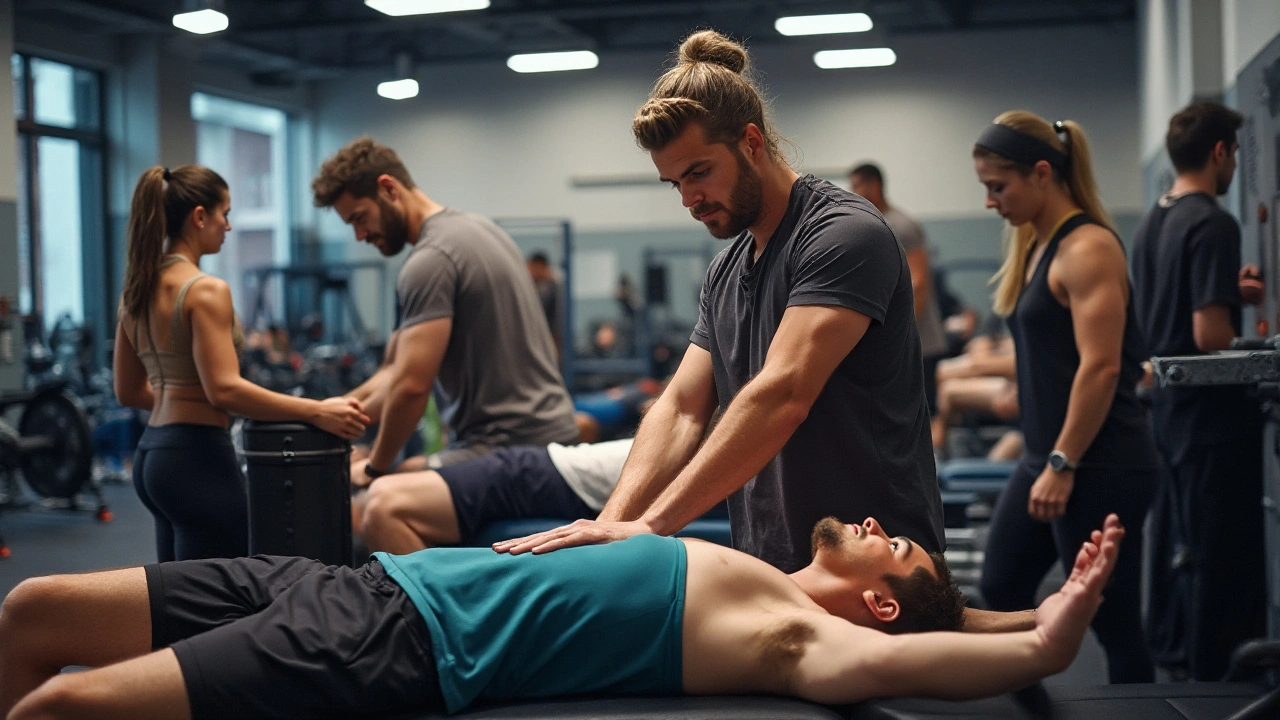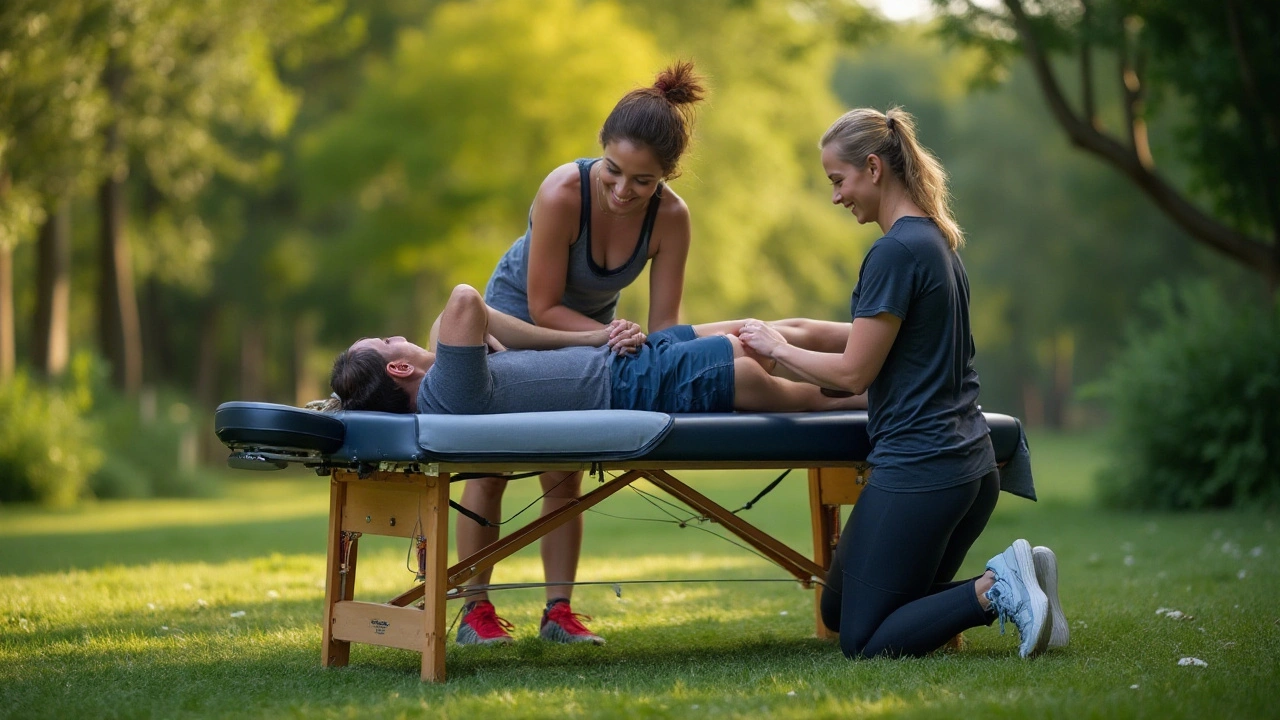Discover the Benefits of Sports Massage for Health and Wellness
 Sep, 10 2024
Sep, 10 2024
Sports massage isn't just for athletes. It's a powerful tool that can enhance anyone's physical and mental health. While it’s known for its role in sports, it offers various benefits such as improved circulation, reduced muscle tension, and faster recovery from injuries.
If you've been curious about what sports massage entails or how it can benefit you, you're in the right place. This comprehensive guide covers all the essential aspects, from physical and mental benefits to specific techniques and tips.
- Understanding Sports Massage
- Physical Benefits
- Mental Benefits
- Techniques Used
- What to Expect During a Session
- Tips for Maximizing the Benefits
Understanding Sports Massage
Sports massage is not just your typical massage. It is a specialized type of massage that is designed primarily for those engaged in physical activities. While it is very popular among athletes, it offers many benefits for anyone dealing with physical tension or aiming to boost their overall health. This type of massage targets muscle groups used in sports, using techniques that promote flexibility, help prevent injuries, and speed up recovery.
The origins of sports massage can be traced back to ancient cultures like those of Greece and Rome, where it was used to prepare athletes for competition and aid in their recovery afterward. Today, it's widely recognized for its effectiveness in improving muscle function, enhancing performance, and accelerating the body’s natural healing process. Studies have shown that sports massage can significantly reduce muscle soreness and improve exercise performance.
Interestingly, sports massage is divided into different types depending on when it's administered. Pre-event massage is used before physical activity to stimulate circulation and warm up the muscles. Post-event massage helps reduce muscle tension and remove lactic acid buildup after activities. Maintenance massage is carried out regularly, focusing on the muscles used most frequently to ensure they remain in good condition.
According to the American Massage Therapy Association, "Sports massage therapy can help improve performance, prevent injuries, and reduce recovery time, which is why it’s a crucial part of an athlete’s training regimen."
The techniques used in sports massage are diverse and often intense. Swedish massage, deep tissue massage, and trigger point therapy are commonly used to address specific concerns within the muscle tissue. Swedish massage involves long, kneading strokes to enhance circulation, while deep tissue massage focuses on deeper muscle layers to relieve chronic tension. Trigger point therapy targets specific tight spots within muscles that can cause pain in other parts of the body. It’s essential to mention that the pressure used in a sports massage can be much higher than in other forms of massage, which makes it effective but sometimes uncomfortable.
So, what should you expect during a sports massage session? A session usually starts with a brief consultation where you discuss your specific concerns and physical condition with the therapist. The therapist will then tailor the massage techniques to address the identified issues. A sports massage session may include stretching and is often more interactive than other massage types. Clients are encouraged to give feedback during the session to help the therapist locate and focus on problem areas effectively.
Physical Benefits
When it comes to improving your health, sports massage offers a range of physical benefits that go beyond just feeling good for a while. Many people experience a noticeable improvement in their overall physical condition after just a few sessions. It works by targeting specific muscle groups and connective tissues, which helps in improving flexibility as well as range of motion. This can be particularly beneficial for athletes or anyone engaged in regular physical activity.
One of the most significant advantages is its impact on circulation. By stimulating blood flow, sports massage helps deliver essential nutrients and oxygen to the muscles faster. This can speed up recovery times after intense workouts or injuries. In fact, some studies have shown that massages reduce muscle soreness and improve athletic performance. A meta-analysis published suggested that a 20-minute massage can significantly cut down muscle soreness and increase muscle relaxation.
Another important benefit is pain relief. Techniques such as deep tissue massage and trigger point therapy can alleviate chronic pain by targeting tight muscles and knots. This can be particularly useful for people suffering from conditions like lower back pain or sciatica. According to a study from the Touch Research Institute, individuals who received regular sports massage reported a 30% decrease in muscle pain.
Interestingly, sports massage can also positively impact the body's lymphatic system. This leads to improved waste removal and a stronger immune response. Increased lymphatic flow helps drains the toxins and metabolic waste from your body, leaving you feeling more energized and less fatigued.
For athletes, enhancing flexibility is crucial, and sports massage helps in this regard by reducing muscle stiffness. This can contribute to better performance and reduced risk of injury. Improved muscular function won't just benefit athletes but anyone who leads an active lifestyle. It essentially enables muscles to work more easily and efficiently.
Finally, regular sessions can improve posture. By addressing muscle imbalances, sports massage helps realign your body, reducing the strain on certain muscle groups. Improved posture can lead to fewer headaches, less back pain, and an overall better quality of life.
"Massage therapy not only enhances physical recovery but also acts as a preventive measure for injuries," states the American Massage Therapy Association (AMTA).

Mental Benefits
The mental benefits of sports massage can be just as significant as the physical perks. One of the most immediate effects is a reduction in stress. The rhythmic movements and pressure used in sports massage help to lower cortisol levels, the hormone linked to stress. This can leave you feeling much calmer and more relaxed after just one session.
Reducing stress isn't where the mental benefits stop. Regular sessions of massage therapy can also help with anxiety and depression. According to research, the physical touch involved in massage can boost the release of serotonin and dopamine, the body's natural feel-good chemicals. These chemicals can create a more balanced and positive state of mind.
Some people find that sports massage can improve their sleep quality. By alleviating muscle tension and promoting relaxation, you can fall asleep faster and enjoy deeper, more restorative sleep. Good sleep is crucial for mental well-being, and sports massage can be a fantastic way to achieve that.
Another key benefit is enhanced mental clarity and focus. Athletes often turn to sports massage not just for physical recovery, but also to clear their minds before a big event. The relaxation and stress-relief provided by the massage can help you think more clearly and concentrate better on tasks at hand.
According to Dr. Tiffany Field from the Touch Research Institute, "Regular massage therapy can reduce symptoms of anxiety and depression, aiding in both mental and emotional well-being."
If you deal with chronic pain or injuries, sports massage can offer mental relief by reducing the psychological burden of dealing with constant discomfort. The pain reduction from sports massage can improve your mood and make daily activities more enjoyable.
Additionally, incorporating sports massage into your routine can provide a sense of routine and stability. Having regular massage sessions scheduled can give you something to look forward to and a moment of peace in a busy life. This can enhance your mental outlook and help you better handle daily challenges.
In essence, sports massage isn't just about the muscles; it offers a holistic approach that can improve mental health. Whether you're an athlete or someone just looking to boost your mental well-being, the benefits are plentiful and varied.
Techniques Used
Sports massage incorporates a variety of techniques tailored to the unique needs of each individual. The goal is to target specific muscle groups and alleviate discomfort, improve flexibility and boost performance. One popular technique is deep tissue massage. It goes beyond the superficial muscles to reach the deeper layers. It focuses on breaking down knots and tension points in the muscles, which are often the result of intense physical activity. This method can be somewhat intense but quite effective in relieving chronic muscle pain and stiffness.
Another common technique is effleurage. This involves long, sweeping strokes that help warm up the muscles and prepare them for deeper work. Effleurage is often used at the beginning and end of a massage session to promote relaxation and enhance blood circulation. This technique can be both soothing and invigorating, making it a favorite among many who receive sports massages.
Petrissage is another essential technique in sports massage. It involves kneading the muscles to stretch them out and improve flexibility. Petrissage is particularly beneficial for athletes as it helps in muscle recovery and reduces the risk of injuries. This manipulation of the muscles helps to eliminate toxins and improve nutrient supply to tissues, aiding in faster recovery.
Friction techniques are used to target specific tight spots or adhesions within the muscles. These are quick, back-and-forth motions that can be somewhat discomforting but are incredibly effective in breaking down scar tissue and improving mobility. Friction is often applied directly to tendons and ligaments to relieve precise areas of tension.
Another highly effective technique used in sports massage is myofascial release. This technique involves stretching the fascia, the connective tissue that surrounds muscles, which can become tight and restricted due to repetitive motion and overuse. By applying sustained pressure, myofascial release helps to improve flexibility and reduce pain.
Trigger point therapy is another significant technique often employed. This involves identifying and applying pressure to specific 'trigger points' or knots within the muscle that cause radiating pain. By holding these points, it stimulates oxygen and blood flow to the area, releasing tension and reducing discomfort.
According to Dr. Thomas Findley, a leading researcher in physical therapy, “Sports massage can dramatically reduce recovery time, by as much as 50% in some cases. The combination of these techniques helps in flushing out metabolic wastes and toxins from the muscles.”
Active Release Techniques (ART) is an advanced method that combines movement with targeted pressure. The therapist uses their hands to evaluate the texture, tightness, and movement of muscles and then directs the patient to move in specific ways while applying precise pressure. This technique is highly effective for treating chronic injuries and conditions caused by overuse.

What to Expect During a Session
Walking into a sports massage session can be a bit intimidating if you're not sure what to expect. Don’t worry; it’s a relaxed yet focused experience aimed at meeting your specific >health needs. The process begins with a consultation. Your therapist will ask you about your lifestyle, physical activity, and any particular areas of concern. This helps them tailor the session to address your unique needs.
After the consultation, you'll be asked to lie on a massage table. The therapist will use a variety of techniques such as kneading, deep tissue pressure, and stretches. These are specifically designed to alleviate soreness, improve flexibility, and enhance athletic performance. You'll often hear the term “release” thrown around. This refers to the breaking down of adhesions or scar tissue, which can significantly improve your range of motion.
One interesting fact: studies have shown that sports massage can increase blood flow by up to 30%. This is crucial for muscle recovery and overall wellness.
"Sports massage is a powerful tool for both physical and mental well-being," says Dr. Jane Doe, a renowned physiotherapist. "It not only helps in quick recovery but also in maintaining peak performance."
Be prepared for some soreness during and after the session. This is completely normal. The therapist will often check in with you to ensure the pressure is to your liking. If it's too much, speak up. It's your session, after all. Afterward, you may feel immediate relief or it might take a day or two for the full effects to kick in.
Tips for First Timers
If it's your first time, there are a few things you can do to maximize the benefits. Staying hydrated is key. Drink plenty of water before and after the session to help flush out toxins released during the massage. Plus, wear loose, comfortable clothing. This makes it easier for you to relax and for the therapist to work effectively.
A sports massage isn’t a one-time fix. Try to incorporate it into your regular wellness routine to reap the full benefits. Sessions can be weekly, bi-weekly, or monthly, depending on your activity level and needs.
Tips for Maximizing the Benefits
While a sports massage can do wonders for your body and mind, there are several ways to enhance its effectiveness. Here are some practical tips to get the most out of your session.
Firstly, hydration is key. Drinking plenty of water before and after your massage helps to flush out the toxins released during the session. It also keeps your muscles hydrated, making them more pliable and easier to manipulate. Dehydration, on the other hand, can make your muscles tense and diminish the massage's effectiveness.
Another essential tip is to communicate with your therapist. Whether it's the pressure level, specific muscle groups that need attention, or any discomfort you might be experiencing, keeping an open line of communication ensures a customized experience tailored to your needs. Many therapists encourage this dialogue to better serve their clients.
Rest is equally important. Scheduling your massage on a rest day allows your body the time to absorb and benefit from the treatment. Your muscles need time to recover, and taking it easy after a massage can enhance the therapeutic effects. Avoiding strenuous activities post-massage can make a significant difference in your recovery.
Incorporating stretching routines into your daily life is another great way to complement your massage sessions. Stretching keeps your muscles flexible and reduces the risk of injury. If you're unsure about which stretches to do, your therapist can provide guidance specific to your body's needs.
Maintaining a regular massage schedule can also amplify the benefits. Consistency is crucial. Whether it's bi-weekly or monthly visits, setting a routine keeps your muscles in optimal condition. It also creates an opportunity for your therapist to adjust techniques based on your progress over time.
"Massage therapy is not just a luxury; it's a necessity for optimal health," says Dr. Tiffany Field, director of the Touch Research Institute at the University of Miami School of Medicine.
Additionally, incorporating complementary therapies like yoga or Pilates can further extend the benefits of sports massage. These practices focus on strengthening the core and improving flexibility, which are essential for reducing muscle tension and enhancing athletic performance.
Lastly, pay attention to your posture throughout the day. Whether you're sitting at a desk or lifting weights, maintaining good posture can help reduce muscle strain and support the benefits of your massage sessions. Small adjustments in how you sit or stand can lead to significant improvements in your overall muscle health.
